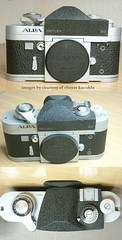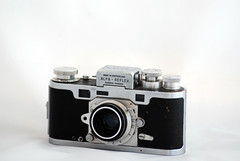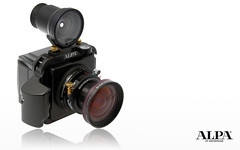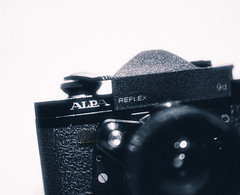Difference between revisions of "Alpa"
m (→Fifth Generation: added references.) |
m (further references, fixed footnote text.) |
||
| Line 33: | Line 33: | ||
====Pignons Era==== | ====Pignons Era==== | ||
| − | There were five distinct generations of Alpa cameras produced | + | There were five distinct generations of Alpa cameras produced by Pignons, the last of which was manufactured in Japan under license. |
=====First Generation===== | =====First Generation===== | ||
| − | Unlike later generations, all of these models offered a coupled rangefinder; the Alpa Standard, however, did not offer reflex viewing. | + | Unlike later generations, all of these models offered a coupled rangefinder; the Alpa Standard, however, did not offer reflex viewing<ref>[http://www.alpareflex.com/Cameras/AlpaStandard.htm Alpa Standard] at [http://www.alpareflex.com/ alpareflex.com]</ref>. |
* Alpa Standard | * Alpa Standard | ||
| Line 65: | Line 65: | ||
=====Fifth Generation===== | =====Fifth Generation===== | ||
| − | Based on Chinon models, these bear little relation to other cameras bearing the Alpa name, and cannot mount previous lenses.<ref>[http://www.alpareflex.com/Cameras/Si2000.htm]</ref><ref>[http://www.alpareflex.com/Cameras/Si3000.htm]</ref> | + | Based on Chinon models, these bear little relation to other cameras bearing the Alpa name, and cannot mount previous lenses.<ref>[http://www.alpareflex.com/Cameras/Si2000.htm Alpa Si 2000] at [http://www.alpareflex.com/ alpareflex.com]</ref><ref>[http://www.alpareflex.com/Cameras/Si3000.htm Alpa Si 3000] at [http://www.alpareflex.com/ alpareflex.com]</ref> |
* Alpa Si 2000 | * Alpa Si 2000 | ||
Revision as of 02:40, 15 April 2012

|
| 1960s Alpa 9d body image by eBayer kucuklu (Image rights) |

|
| Alpa Reflex II, 1945-52 image by Missy Bergen (Image rights) |
Alpa is the brand name of successive generations of high-quality 35mm SLR cameras made by the Swiss manufacturer Pignons S.A. It was of an unusually solid construction, and featured a cast metal body with figured surfaces. Controls were very simple, consisting of only a film-advance lever, and a shutter-speed indicator. Lenses were labeled "Kern-Switar." The standard lens for the Alpa 10d was a macro 50mm lens, unusual for its time.
The original design was called the Bolca Reflex and had been made by Jacques Bogopolsky, who had already designed the Bolex movie camera (see Bolsey). The rights were bought by Pignons in 1942, who named the camera the Alpa Reflex.
Alpas were very expensive hand-made cameras, made of carefully selected materials, with many variants that could be produced on special order. The company ceased camera production in 1990 and liquidation was initiated.
Contents
Cameras

|
| Alpa 12 TC image by Carlos Echenique (Image rights) |
Pignons Era
There were five distinct generations of Alpa cameras produced by Pignons, the last of which was manufactured in Japan under license.
First Generation
Unlike later generations, all of these models offered a coupled rangefinder; the Alpa Standard, however, did not offer reflex viewing[1].
- Alpa Standard
- Alpa Reflex
- Alpa Prisma Reflex
Second Generation (Alnea models)
- Alpa Alnea/Reflex model 4
- Alpa Alnea/Reflex model 5
- Alpa Alnea/Reflex model 6
- Alpa Alnea/Reflex model 7
- Alpa Alnea/Reflex model 8
Third Generation
The third generation of Alpa SLRs introduced built-in meters, both conventional (Model 6c) and TTL (Model 9d).
- Alpa 6c[2]
- Alpa 9 (9d/9f)
Fourth Generation
- Alpa 10d
- Alpa 11 (11e, 11el, 11si, 11z)
Fifth Generation
Based on Chinon models, these bear little relation to other cameras bearing the Alpa name, and cannot mount previous lenses.[3][4]
- Alpa Si 2000
- Alpa Si 3000
Capaul & Weber era
The Alpa trademark was purchased by new owners Capaul & Weber in 1996. Later that year, the Alpa name was revived for a prototype of a new, premium-level medium format camera, the Alpa 12. Production models of the 12WA, and 12/SWA (with built-in perspective control) followed in 1998. All of these cameras had a modular design that accepts a variety of superb wide-angle lenses from Rodenstock, Carl Zeiss, and Schneider. In 2007 the new enterprise became the ALPA Capaul & Weber AG.
- Alpa 12 TC
- Alpa 12 WA
- Alpa 12 SWA
- Alpa 12 MAX
- Alpa 12 Metric
- Alpa 12 XY
Notes
- ↑ Alpa Standard at alpareflex.com
- ↑ Alpa Reflex 6c with Makro-Switar 50 mm f/1.8, sold at the November 2011 Westlicht auction in Vienna.
- ↑ Alpa Si 2000 at alpareflex.com
- ↑ Alpa Si 3000 at alpareflex.com
Links

|
| black-finish Alpa 9d image by tgrill1 (Image rights) |
- company homepage
- Alpa Reflex Cameras from Switzerland at alpareflex.com
- Alpa Reflex Series D at Collection Even
- Alpa Cameras at www.collection-appareils.fr
- Alpa English instruction manuals at Orphancameras.com
- Alpa 6B at Au fil des Images (in French)
- Alpa Cameras Price Guide, Photos, Descriptions at collectiblend.com